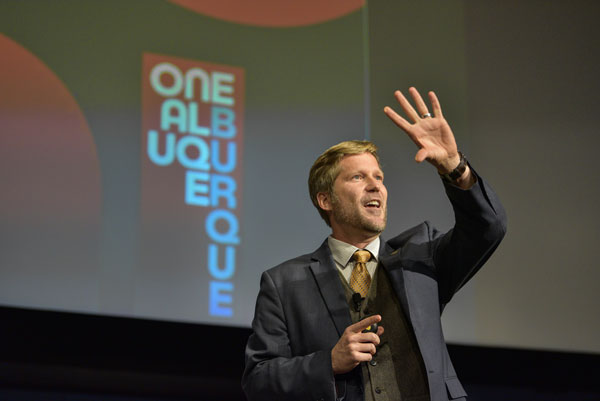City leader discusses crime, diversity and a brighter community future
Albuquerque faces a diverse set of problems, and many will need the big-picture, analytical solutions for which Sandia’s workforce is known, Mayor Tim Keller told attendees at the November session of the Labs’ Community Engagement Speakers Series.
Keller discussed the state of the city and the challenges it faces: discouraging crime rates, economic struggles and the brain drain of young talent leaving the state to look for

work. The mayor also outlined his strategies for moving the community forward.
“We have a powerful story to tell about cultural cross-roads and resilience,” Keller said. “It should be the basis of our pride and our story and what the world knows about us. We have to take ownership of our own future.”
Introduced by deputy Labs director Dave Douglass as “Albuquerque’s most passionate and greatest supporter and cheerleader,” Keller began by thanking the Labs for its role as a valued partner to the city.
Born and raised in Albuquerque, Keller attended the University of Notre Dame and earned an MBA with honors from the Harvard Business School. Prior to being elected mayor, he served two terms in the state senate and was state auditor. Keller also learned about Sandia’s tech transfer activities during a brief stint as chair of the Science and Technology committee in the state legislature. His wife, Elizabeth Kistin Keller, is a member of Sandia’s technical staff, so he said he’s seen the Labs first hand at Family Day.
More than a TV show
Outside the state, Albuquerque is recognized primarily by the Breaking Bad television series and the Balloon Fiesta, associations that he said hold it back.
“We have much more going for us than we give ourselves credit for. We are more than a TV show, and more than a two-week festival. But we have to remember how we got here,” Keller said.
Albuquerque has always been a city at a crossroads between the plains and the western lands, Keller said, a trading center along the Camino Real, the Santa Fe Trail, Route 66 and today’s rail crossings and the Big I.
“We should be a safe, innovative and inclusive com-munity,” Keller said. “The challenge today is that we’re not there. We’re actually pretty far from that.”
Policing comprises nearly 2/3 of the city budget. Adding more than 100 officers this year, in addition to overtime for the current force, will leave the city unable to undertake needed projects, he said.
“The previous administration put together an amazing real-time crime center. But without extra capacity, we can’t do proactive or predictive things, so right now it is ‘the catch up crime center.’”
A planned community policing model demands assignment of non-overtime officers to multiple locations, a tremendous financial and logistical problem.
“It’s an analytical exercise that, right now, we just don’t have the math to solve,” Keller said.
And Albuquerque needs help with other large-scale analytical problems.
“We have all the data you could ever want, but we don’t have anybody to do the analysis,” Keller said.
Another logistical challenge he pointed to is homelessness.
“Albuquerque is one of the only major cities that lacks a centralized place to go for services,” Keller said.
Dozens of nonprofits help the homeless in different ways, but they’re spread throughout the city, so it could take an individual all day trying to get from job training to health care to lunch and then to someplace to sleep.
“We have to have a centralized place where people can go to access service providers,” the mayor said.
Another challenge is mapping educational enrichment opportunities and creating new ones for children to supplement the Albuquerque Public Schools with extracurricular and summer programs. He said the city provides such programs for about 20,000 children, but he wants to serve around 80,000.
The city is also looking for ways to implement the Smart City program, installing cameras and sensors to optimize transit and other services, Keller said, and is working with PNM to increase solar capacity.
Keller half-jokingly mentioned that the city has a battery chemistry problem, an oblique reference to the much-maligned ART electric bus project he inherited, which recently rejected all buses due to their ineffective batteries.
“We’d like it if someone can make a bus battery that can have a 270-mile range. We know that the competition can only do 100 hours,” Keller said.
One of Albuquerque’s biggest draws, the Balloon Fiesta, brings with it logistical concerns. Traffic delays are up significantly during the fiesta, in part because the city has outgrown the Balloon Park and most nearby land is in private hands. Finding a solution will require more brain power, he said.
Keller closed by asking that people volunteer and point potential candidates to the city’s jobs. Volunteer coordinators from the city of Albuquerque were on hand to discuss volunteer opportunities in the Albuquerque Police Department and other city services.
The Community Engagement Speakers Series offers Sandia staff a way to discuss community issues and learn how to make a direct, positive impact. Sandia members of the workforce can view a videostream of the talk here, or visit the Speaker Series website to view other talks.